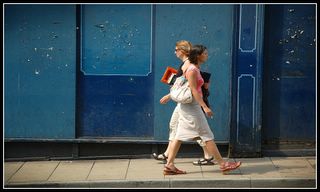The world is a stage upon which all of us perform as we go about our daily routines, often oblivious to the moments of pure chance that occur so randomly, like passing a stranger and exactly matching their stride, attitude and way of holding something.
As a photographer I enjoy observing and in a sense ordering these events by choosing to push the shutter at the decisive moment.
When it comes to street photography you can broadly speaking adopt two strategies. Chase after a subject by keeping on the move and hunting for the right coincidence to occur in front of your lens. Or you can 'set the stage' by looking for an interesting background or scene, and then just wait for life to unfold in front of your lens.
I like doing both but I think that you stand the most chance of getting something valuable if you adopt the latter strategy. It allows you to consider the elements of composition and light carefully. You can even prefocus. Wait patiently and something will happen. The picture below is part of a series taken where I used this interesting slice of the city as my stage.
Paul Indigo

Capturing the decisive moment.
As a photographer I enjoy observing and in a sense ordering these events by choosing to push the shutter at the decisive moment.
When it comes to street photography you can broadly speaking adopt two strategies. Chase after a subject by keeping on the move and hunting for the right coincidence to occur in front of your lens. Or you can 'set the stage' by looking for an interesting background or scene, and then just wait for life to unfold in front of your lens.
I like doing both but I think that you stand the most chance of getting something valuable if you adopt the latter strategy. It allows you to consider the elements of composition and light carefully. You can even prefocus. Wait patiently and something will happen. The picture below is part of a series taken where I used this interesting slice of the city as my stage.
Paul Indigo

Capturing the decisive moment.
Comments